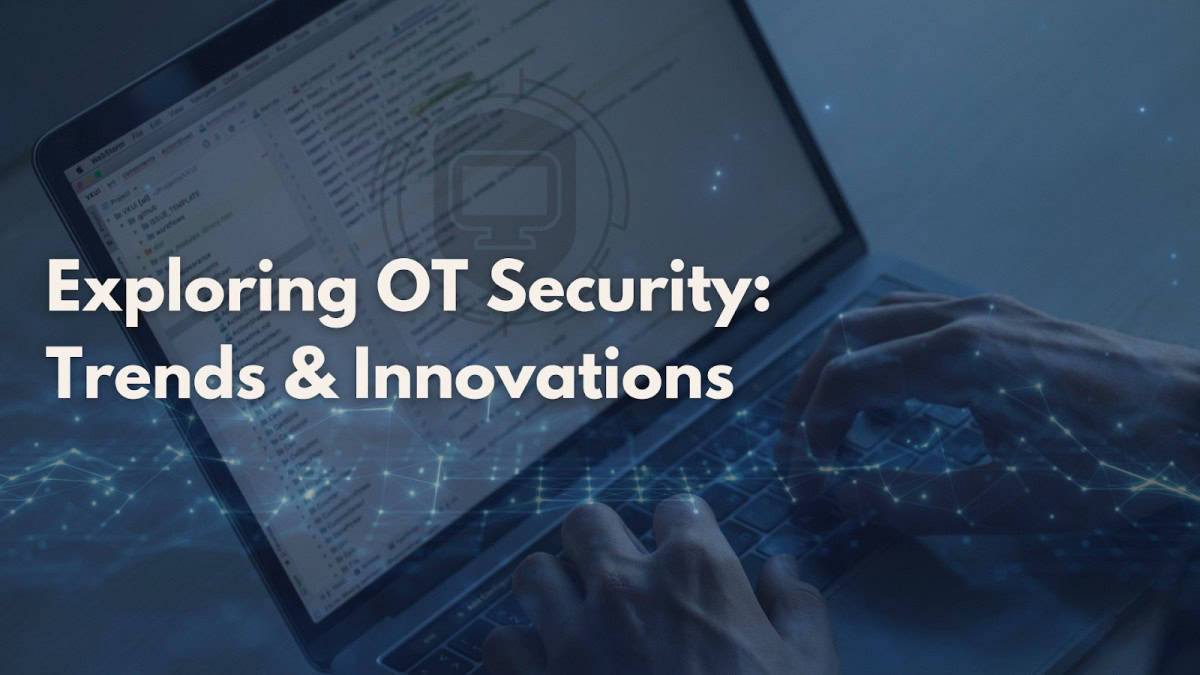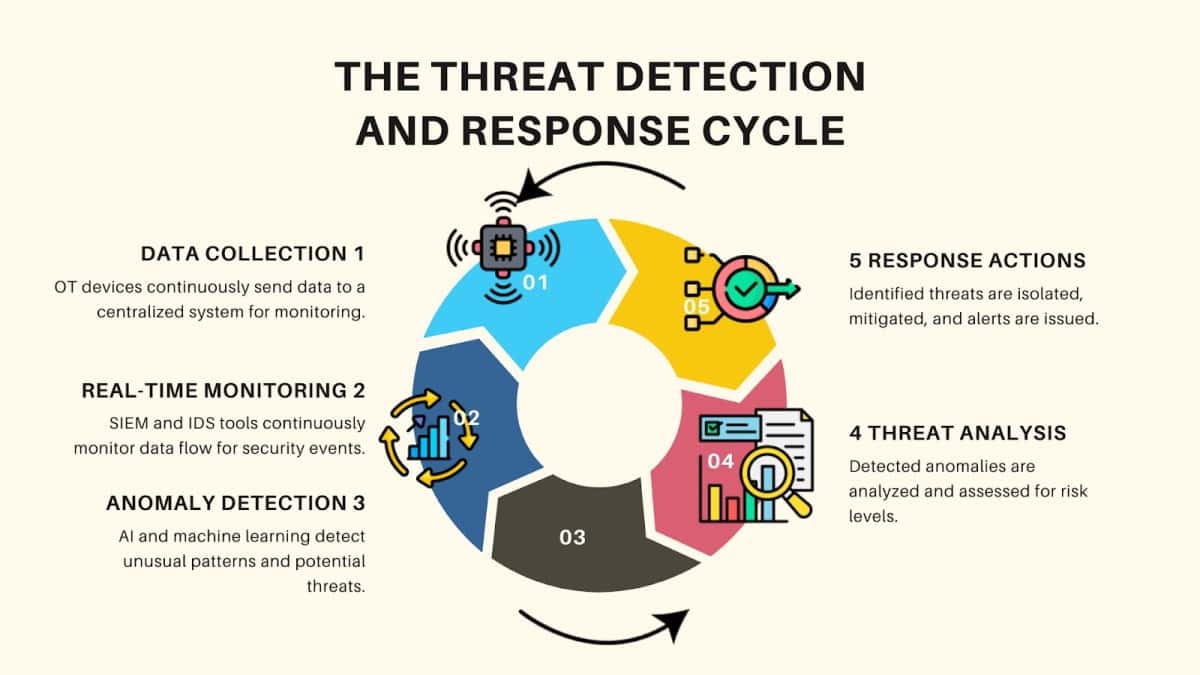
Operational Technology (OT) security is rapidly emerging as a significant component of the cybersecurity industry, driven by the increasing dependence of various sectors on systems for critical operations. Unlike traditional Information Technology (IT) systems, OT includes both software and hardware components designed to detect or bring about changes by directly observing and influencing physical objects, systems, and events. This article discusses current trends and developments in OT security, focusing on emerging threats and the new and improved security technologies developed to protect against them.
Understanding the OT Landscape
Operational Technology refers to systems used in industrial control systems (ICS), such as supervisory control and data acquisition (SCADA) systems, distributed control systems (DCS), and other control systems used in manufacturing, energy, transportation, and utilities. These systems are critical to the smooth functioning of essential services and industries.
Initially, OT systems operated as standalone entities, independent of business IT networks and the Internet. However, the advancement in the Industrial Internet of Things (IIoT) and the integration of IT and OT networks have made these systems vulnerable to cyber threats that were initially in the IT realm. The above integration makes work and operations much more efficient and effective but comes with risks and vulnerabilities.
Best 5 Emerging Trends in OT Security
Advancements in OT security solutions are transforming industrial systems’ ability to defend against cyberattacks. Such technologies are blockchain and digital twins with related approaches, including edge computing, to strengthen the defense and cybersecurity of these systems.
1. Convergence of IT and OT Security
As IT and OT systems integrate, security measures can no longer remain isolated. Companies are beginning to implement holistic security models that interconnect IT and OT security to cover all the layers. Therefore, as both domains continue to expand, the necessity arises for security solutions tailored to their specific requirements while facilitating information exchange.
2. Increased Focus on Threat Intelligence
With the escalation of cyber threats targeting OT systems, the importance of threat intelligence has emerged. Organizations are now acquiring sophisticated threat identification and surveillance technologies that provide real-time analysis. These tools use machine learning and artificial intelligence (AI) to analyze the data and detect suspicious and anomalous activities, which can then be prevented before they occur.
3. Zero Trust Architecture
Another emerging concept in OT security is the zero-trust security model, which is based on the concept of trusting nothing and verifying everything. This approach involves authenticating every individual and device desiring to access network resources both internally and externally. Considering the Zero-Trust approach, one can reduce the risks of unauthorized access and data transfer within the OT environment.
4. Enhanced Endpoint Security
As OT devices grow more connected, protecting endpoints is critical. Modern endpoint security solutions apply to OT devices, including sensors, controllers, HMI (Human-Machine Interfaces), and PLCs (Programmable Logic Controllers). Such solutions are based on device authentication, secure boot, and real-time threat detection and prevention.
5. Regulatory Compliance and Standards
Regulatory bodies and industry groups are increasingly establishing standards and guidelines for OT security. Compliance with frameworks such as the NERC CIP (North American Electric Reliability Corporation Critical Infrastructure Protection) is becoming essential for organizations operating critical infrastructure. Adherence to these standards not only ensures better security practices but also helps in avoiding legal and financial repercussions.
Best 6 Innovations in OT Security
New developments in OT security are revolutionizing safeguarding infrastructure and industrial processes from cyber risks. Now, it is time to take a closer look at the most innovative innovations driving OT security and their significance for protecting vital processes.
1. Advanced Threat Detection and Response
Some of the new developments focus on threat detection and response mechanisms in OT environments. Products such as Security Information and Event Management (SIEM) systems and Intrusion Detection Systems (IDS) are being developed suited for the OT context. These tools offer constant surveillance and analysis, alerting users to possible risks and suspicious activities in real-time. Also, implementing artificial intelligence and machine learning improves the capacity to identify and address new threats.

2. Network Segmentation and Micro-Segmentation
Network segmentation refers to the process of partitioning a network into several sections that are confined to prevent a breach from spreading. Micro-segmentation builds on this by dividing segments into small zones with individual security parameters. This granular approach means that even if the attackers penetrate one part of the region, their movements are limited, hence minimizing the impact.
3. Secure Remote Access Solutions
The COVID-19 pandemic hastened the growth of secure remote access solutions since many OT environments needed to be monitored and managed remotely. Such advancements include VPNs, secure gateways, and strong authentication mechanisms. Security measures such as MFA and SASE are being implemented as standard practice to ensure that any form of working remotely does not weaken OT security.
4. Blockchain Technology
There is a discussion on how blockchain systems can improve OT security. Because of its decentralization and non-alterability, blockchain can serve as a means of ensuring data integrity and authenticity in the OT. Use cases of blockchain applied to OT include firmware update management, identity management, and safeguarding significant transactional records.
5. Digital Twins
OT security is being transformed by digital twins, virtual copies of tangible objects. The virtual environment allows organizations to simulate and monitor physical systems to identify any signs of threats. Digital twins facilitate predictive maintenance, minimize service time, and improve security while providing a constant audit of the system and its enhancements.
6. Edge Computing and Secure Edge Devices
Edge computing ensures that the required computational power is processed nearer to the data source, thus helping lower latency and better real-time decision-making. Safeguarded edge computing devices use security capabilities like encryption and access restrictions to secure data at the edge of networks. This ensures that all personal or restricted data does not leak out at the peripheries of the network.
Challenges and the Road Ahead
Despite the progress made in OT security, some key areas need to be addressed. The first issue is that many existing OT systems are legacy systems. Earlier systems may not be fortified with modern security processes and are challenging to integrate without interfering with business flow. Implementing security measures with these legacy systems presents many challenges that must be addressed.
Another problem is the scarcity of specifically trained cybersecurity specialists familiar with IT and OT environments. Overcoming this skills deficiency is necessary for the proper deployment and management of OT security solutions. To foster an increased understanding of OT environments, organizations need to focus on training and developing a capable workforce.
In the future, more advancements in technology development and cooperation between the related parties would form the trend of OT security. Collaboration between the public and private sectors, information exchange, and the creation of open standards will also be crucial for improving the security of critical infrastructure.
Conclusion
The integration of IT and OT has helped improve industrial processes but has also created new risks. As the threat landscape changes, the approaches and solutions used to protect OT systems should also adapt. Thus, by keeping abreast of emerging trends and implementing innovative approaches, organizations can safeguard their crucial assets and guarantee the availability of vital services.
The emerging approach of threat intelligence, network segmentation, secure remote access, and integration of new technologies like blockchain and digital twins will be the paths forward. Addressing the issues of dealing with legacy systems and skills deficits will be a collective undertaking among various players.
Finally, the concept that shapes OT security is to achieve a high level of protection that can effectively counter the growing threat landscape. Dedicating efforts toward improvement and innovation will help organizations protect themselves and the overall stability and security of the digital world.
FAQs
What is the difference between IT and OT security?
IT security focuses on protecting data and information systems, ensuring the confidentiality, integrity, and availability of data. OT security, on the other hand, emphasizes the protection of physical processes and equipment, ensuring the safe and reliable operation of industrial systems and critical infrastructure.
Why is OT security becoming more important now?
The increasing convergence of IT and OT networks, driven by the Industrial Internet of Things (IIoT), has exposed OT systems to cyber threats that were traditionally confined to IT environments. This integration enhances operational efficiency but also introduces new vulnerabilities that require robust security measures.
What are the main challenges in implementing OT security?
One of the main challenges is securing legacy OT systems that lack modern security features and are difficult to update without disrupting operations. Additionally, there is a shortage of skilled professionals with expertise in both IT and OT, making it challenging to manage and secure these environments effectively.
Daniel Raymond, a project manager with over 20 years of experience, is the former CEO of a successful software company called Websystems. With a strong background in managing complex projects, he applied his expertise to develop AceProject.com and Bridge24.com, innovative project management tools designed to streamline processes and improve productivity. Throughout his career, Daniel has consistently demonstrated a commitment to excellence and a passion for empowering teams to achieve their goals.